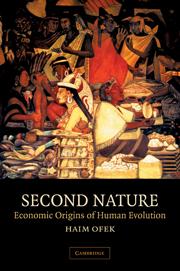Book contents
- Frontmatter
- Contents
- Acknowledgments
- 1 Introduction
- Part 1 Bioeconomics
- Part 2 Paleoeconomics
- 8 Departure from the feed-as-you-go strategy
- 9 The origins of market exchange
- 10 Domestication of fire in relation to market exchange
- 11 The Upper Paleolithic and other creative explosions
- 12 Transition to agriculture: the limiting factor
- 13 Transition to agriculture: the facilitating factor
- References
- Index
10 - Domestication of fire in relation to market exchange
Published online by Cambridge University Press: 06 July 2010
- Frontmatter
- Contents
- Acknowledgments
- 1 Introduction
- Part 1 Bioeconomics
- Part 2 Paleoeconomics
- 8 Departure from the feed-as-you-go strategy
- 9 The origins of market exchange
- 10 Domestication of fire in relation to market exchange
- 11 The Upper Paleolithic and other creative explosions
- 12 Transition to agriculture: the limiting factor
- 13 Transition to agriculture: the facilitating factor
- References
- Index
Summary
Calorie for calorie, fuel is less expensive than food. This is, fundamentally, the only explanation for the close tie of humans to fire – an unexpected reliance of a carbon based life form on an unruly combustive chemical reaction. The impact of fire on civilization from the hearth to the microwave oven is fairly well recorded. Yet, by comparison, the bearing of fire on human evolution prior to civilization is still poorly understood and far more speculative. Given its antiquity in human use, from 300,000 years according to fairly conservative indications, up to 1.5 million years according to others, it is hard to escape the conclusion that fire had a role to play not only as an agent of civilization but also as an agent of evolution promoting hardwired adaptations – not in the least, incitement to trade. Human use of fire, I will argue in this chapter, both facilitated, and was facilitated, by early forms of market exchange.
Nonhuman use of fire
Before we examine the use of fire by humans, it would be appropriate to examine its exploitation by certain forms of life other than human. However opportunistic and passive, the practice is apparent in plants more than in animals for a good reason. Unable to flee fire but, making a virtue of a necessity, plants developed elaborated safeguards against it and, occasionally, use its deadly reaches to their own advantage. Plants protect themselves from fire by various means (e.g., by sheltering storage and vital tissues underground) and, consequently, are fireproof to different degrees.
- Type
- Chapter
- Information
- Second NatureEconomic Origins of Human Evolution, pp. 153 - 167Publisher: Cambridge University PressPrint publication year: 2001

